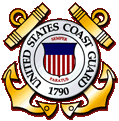



![]()




![]()
"A Snapshot of Life Aboard the USCG Lightship Relief LV-78 / WAL-505 From April 1957 to April 1959."
Photos and information are courtesy of Jay McCarthy, USCG
Lightship Sailor Jay McCarthy recently donated a series of photographs he took while he served on board the LV-78 for two years, from 26 April 1957 to 23 April 1959. His photos, along with his descriptions of each, provide the viewer with a unique glimpse into life on board a Coast Guard lightship in the late-1950's. Since lightships no longer serve, having been replaced by radio and satellite-based aids to navigation, Mr. McCarthy's donation is all the more important. Now future generations can get a feel for what life was like in the "Old Guard" on what were affectionately (and not so affectionately) known as "sunburned watermelons," a term playing off the ships' red hulls.
This photo gallery begins with Mr. McCarthy's description of a typical day on board the lightship and then moves on to his photo album and his captions for each. We have included all of his photos as well as the written material he supplied to us, changing only some of the punctuation. The quotations from his writings are enclosed in quotation marks.
We hope that you will enjoy this brief glimpse into the past, courtesy of a Coast Guard veteran. It will only be through the efforts of veterans such as Mr. McCarthy that we can preserve the full and complete history of the Coast Guard's now vanishing past. Thank you!
Jay McCarthy joined the Coast Guard reserve while still in high school. From 24 February 1955 through 23 April 1957 he served on active-duty with Port Security Unit 03-408. He then transferred to duty on board the Lightship LV-78 / WAL-505, arriving there on 24 April 1957. He tells us of duty on board a lightship:
"Quiet often, duty on a Lightship followed a daily routine, that for the most part was as normal as anybody working on their regular job ashore. The difference came when we experienced time frames of sheer terror and deadly hazards.
On a normal day with good weather, if you were standing the 04:00 to 08:00 watch, you would be treated to a beautiful sunrise, and depending on the time of year and station, a lobster boat, on it's way to work it's traps, would pull alongside and throw today's newspaper (the crew would have read it on the way out) onto our deck. They never stopped, just a wave and a shouted greeting. Their generosity was greatly appreciated by a Lightship crew that now had today's newspaper, and a connection to the world. What a treat! Later in the day would be the daily maintenance tasks, etc., followed by standing the 16:00 to 20:00 watch, where you would be treated to an incredibly beautiful sunset. Quite often on Ambrose Station, you would observe the beautiful ocean liners outbound or inbound to New York Harbor. One evening on Ambrose Station, I had to sound the general alarm, as the outbound ocean liner Stockholm (yes, the same Stockholm that sank the Andrea Doria), came so close to us that we could look directly into the port holes of the passengers' staterooms and see the occupants. A sheer terror moment! The wake of the liner rocked us back and forth for quite some time afterwards.
Raging storms could last for days, with waves breaking over the bow, and then as the bow rose up from under this enormous weight, tons of water would wash down the deck and off the stern. Then the bow would be buried under the next wave and the procedure would repeat itself over and over again. On the first day, everyone would continue to eat, and the cook would place a dampened table cloth on the mess deck table, to keep plates and food from sliding off. As the days of the storm continued, less crewmen would be taking their meals, and would switch to apple and saltines. I don't care what anybody says, if the storm was violent enough and lasted long enough, almost nobody was exempt from being sea sick. Eventually, the seas would calm, winds would blow themselves out, and once more we would be treated to another incredibly beautiful sunset.
On other days, the fog would be so thick, you couldn't see the stern from the wheel house. At times like these, I often would leave the wheel house and spend some time up in the bow (as far away as possible from the loud braying of our foghorn), and listen for the bells and horns of nearby ships. I'm guessing that Bobby Pierce probably did the same thing in the early morning hours of 24 June 1960. Pierce heard the horn of the approaching SS Green Bay and was able to sound the general alarm, two minutes before the collision that sank the ship.
Copyright © 2003 United States Coast Guard Lightship Sailors Association
INC. All rights reserved.
Copyrights also protected by the Digital Millennium Copyright Act of
1998
Revised: 10/23/06.